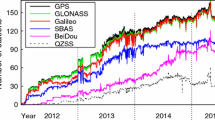Abstract
The International GNSS Service (IGS) issues four sets of so-called ultra-rapid products per day, which are based on the contributions of the IGS Analysis Centers. The traditional (“old”) ultra-rapid orbit and earth rotation parameters (ERP) solution of the Center for Orbit Determination in Europe (CODE) was based on the output of three consecutive 3-day long-arc rapid solutions. Information from the IERS Bulletin A was required to generate the predicted part of the old CODE ultra-rapid product. The current (“new”) product, activated in November 2013, is based on the output of exactly one multi-day solution. A priori information from the IERS Bulletin A is no longer required for generating and predicting the orbits and ERPs. This article discusses the transition from the old to the new CODE ultra-rapid orbit and ERP products and the associated improvement in reliability and performance. All solutions used in this article were generated with the development version of the Bernese GNSS Software. The package was slightly extended to meet the needs of the new CODE ultra-rapid generation.















Similar content being viewed by others
References
Beutler G, Brockmann E, Gurtner W, Hugentobler U, Mervart L, Rothacher M, Verdun A (1994) Extended orbit modeling techniques at the CODE processing center of the International GPS Service for Geodynamics (IGS): theory and initial results. Manuscr Geod 19:367–384
Beutler G, Kouba J, Springer TA (1995) Combining the orbits of the IGS analysis centers. B Géod 69(4):200–222
Beutler G, Rothacher M, Schaer S, Springer TA, Kouba J, Neilan RE (1999) The International GPS Service (IGS): an interdisciplinary service in support of earth sciences. Adv Space Res 23(4):631–653. doi:10.1016/S0273-1177(99)00160-X
Choi KK, Ray J, Griffiths J, Bae T-S (2013) Evaluation of the GPS orbit prediction strategies for the IGS ultra-rapid products. GPS Solut 17(3):403–412. doi:10.1007/s10291-012-0288-2
Dach R, Jean Y (eds) (2013) IGS technical report 2012. IGS Central Bureau, Pasadena
Dach R, Hugentobler U, Fridez P, Meindl M (eds) (2007) User manual of the Bernese GPS Software Version 5.0. Astronomical Institute, University of Bern
Dach R, Brockmann E, Schaer S, Beutler G, Meindl M, Prange L, Bock H, Jäggi A, Ostini L (2009) GNSS processing at CODE: status report. J Geodesy 83(3–4):353–365. doi:10.1007/s00190-008-0281-2
Dach R, Schaer S, Lutz S, Meindl M, Bock H, Orliac E, Prange L, Thaller D, Mervart L, Jäggi A, Beutler G, Brockmann E, Ineichen D, Wiget A, Weber G, Habrich H, Söhne W, Ihde J, Steigenberger P, Hugentobler U (2013) Center for Orbit Determination in Europe (CODE). In: Dach R, Jean Y (eds) IGS technical report 2012:35–46. IGS Central Bureau, Pasadena
Dousa J (2012) Geodetic Observatory Pecný. In: Meindl M, Dach R, Jean Y (eds) IGS technical report 2011:67–74. IGS Central Bureau, Pasadena
Dow JM, Neilan RE, Rizos C (2009) The International GNSS Service in a changing landscape of Global Navigation Satellite Systems. J Geodesy 83(3–4):191–198. doi:10.1007/s00190-008-0300-3
Griffiths J, Choi KK (2013) Analysis Center Coordinator. In: Dach R, Jean Y (eds) IGS technical report 2012:21–34. IGS Central Bureau, Pasadena
Meindl M, Dach R, Jean Y (eds) (2012) IGS technical report 2011. IGS Central Bureau, Pasadena
Mireault Y, Tétreault P, Lahaye F, Héroux P, Kouba J (2008) Online Precise Point Positioning. GPS World 19(9):59–64
Pearlman MR, Degnan JJ, Bosworth JM (2002) The International Laser Ranging Service. Adv Space Res 30(2):135–143. doi:10.1016/S0273-1177(02)00277-6
Rodríguez-Solano CJ, Hugentobler U, Steigenberger P (2012) Impact of Albedo radiation on GPS satellites. In: Kenyon S, Pacino MC, Marti U (eds) Geodesy for planet earth. International Association for Geodesy Symposia, vol 136. Springer, Berlin, pp 113–119. doi:10.1007/978-3-642-20338-1_14
Springer TA, Beutler G, Rothacher M (1999) A new solar radiation pressure model for GPS satellites. GPS Solut 3(2):50–62. doi:10.1007/PL00012757
Springer TA, Enderle W, Agrotis L, Dilssner F, Flohrer C, Pereira F, Romero N, Zandbergen R (2012) The ESA/ESOC IGS Analysis Centre. In: Meindl M, Dach R, Jean Y (eds) IGS technical report 2011:51–60. IGS Central Bureau, Pasadena
Acknowledgments
The work regularly performed by the IGS ACC, in particular the routine comparisons of the IGS AC contributions with the official IGS products, was extremely helpful when developing the new CODE ultra-rapid products. This invaluable material, supported by the quick feedback to our questions provided by the IGS ACC, is gratefully acknowledged.
Author information
Authors and Affiliations
Corresponding author
Rights and permissions
About this article
Cite this article
Lutz, S., Beutler, G., Schaer, S. et al. CODE’s new ultra-rapid orbit and ERP products for the IGS. GPS Solut 20, 239–250 (2016). https://doi.org/10.1007/s10291-014-0432-2
Received:
Accepted:
Published:
Issue Date:
DOI: https://doi.org/10.1007/s10291-014-0432-2




